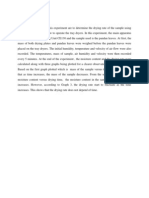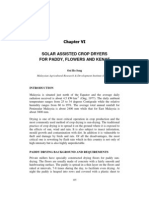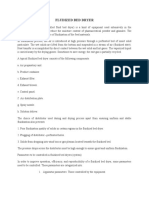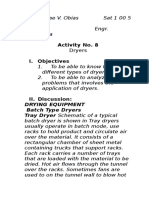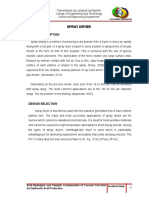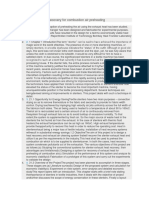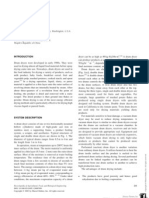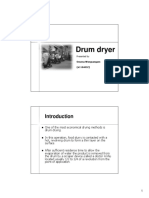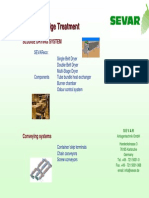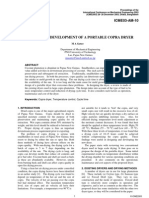Plastic Molding - Drying
Plastic Molding - Drying
Uploaded by
ajnesh1Copyright:
Available Formats
Plastic Molding - Drying
Plastic Molding - Drying
Uploaded by
ajnesh1Original Description:
Original Title
Copyright
Available Formats
Share this document
Did you find this document useful?
Is this content inappropriate?
Copyright:
Available Formats
Plastic Molding - Drying
Plastic Molding - Drying
Uploaded by
ajnesh1Copyright:
Available Formats
Lesson 1
Notes
Recommended Drying Conditions
Resin
Temp.
CFM
Time
PET
325 F
163 C
1.0 - 1.2
4-6
ABS
180 F
82 C
0.6 - 1.0
3-4
PC
250 F
121 C
1.0
3-4
PET with a drying temperature of 325 F (163 C), needs an airflow of
1.0 to 1.2 CFM per pound of plastic processed per hour. ABS, on the
other hand, requires a drying temperature of 180 F (82 C) and an
airflow of 0.6 to 1.0 CFM per pound of plastic processed per hour.
In general, an airflow of around 1.0 CFM per pound of plastic
processed per hour is recommended by most plastic and dryer
manufacturers.
It is possible to over dry a plastic. Over drying can adversely affect
physical properties.
VII. Basic Dryer Designs
A. Oven dryer
1. Used for drying small quantities of a single or different plastic (batch
operation). For example, different colors of the same plastic.
a. Make sure the oven is not overloaded, otherwise the plastic will
not properly dry.
b. Can be operated under vacuum conditions.
Page 5
Plastic Drying Technology - Study Guide
Notes
Oven Dryer
oven
air discharge
blower
heater
Air which has been heated, or heated and dried, is blown into the oven
chamber and over the pellets, picking up moisture from the pellets. The
air containing moisture is discharged from the oven chamber as new air
takes its place.
B. Hopper dryer
1. Off-line dryer
a. Used when the drying system is centralized or for pre-drying
resin.
2. In-line dryer
a. Part of the processing machinery.
3. Portable dryer
a. Mounted on a stand with casters and can be moved from
machine to machine.
Page 6
Lesson 1
Notes
Hopper Dryer
Closed Loop
Filter
air
diffuser
cone
Blower
hopper
flow
diverging
cone
Heater
In the hot air hopper dryer, heated air or heated and dried air is blown
into the lower part of the hopper and is forced through the air diffuser
cone. The air flows over the pellets, picking up moisture. The moisture
laden air exits out the top of the hopper either out of the system in an
open loop system, or back through the system to be re-dried and recirculated in a closed loop system.
4. In order for the hopper dryer design to work effectively, the air must
flow uniformly through the pellets in the hopper. Uniform air flow is
controlled by:
a. The air diffuser cone.
b. A full pellet level in the hopper.
5. Hopper design should promote plug flow. Plug flow is established by:
a. A flow diverging cone - the angle is typically 60 degrees.
b. The height to diameter ratio of the hopper - usually slender and
tall.
6. Tunnel flow - rat holes
a. Channels that form in the pellets in the hopper allowing recently
added plastic, which has not had a chance to properly dry, to
quickly go through the hopper and enter the feed throat of the
process machine.
7. Insulating the hopper
a. The hopper must be insulated when drying temperatures are
above 225 F (107 C).
Page 7
Plastic Drying Technology - Study Guide
Notes
NOTE: It is a good idea to insulate the hopper and air supply hose
regardless of the drying temperature.
Uninsulated Hopper Dryers
higher temperature
lower temperature
Heat is lost through the side walls of an uninsulated hopper. This means
that the plastic at the sides of the hopper will be at a lower temperature
than the plastic in the center of the hopper, and so it will not dry evenly.
But more importantly, an insulated hopper and hoses protect operators
from possible burns.
8. Drying temperatures
a. Above 200 F (93 C), high temperature rating silicone hoses for
the air supply and resin discharge should be used.
b. Above 300 F (149 C), high temperature rating silicone hoses
should be used for the air return as well.
9. Sizing the dryer and hopper
a. Select a dryer with the air flow and temperature capacity for the
plastics you expect to process.
b. Hopper capacity size - the production rate multiplied by the
drying time for the plastic being processed.
C. Closed loop
1. The air is re-dried and re-used over and over.
D. Open loop
1. The air is vented out of the system after it is used once.
Page 8
You might also like
- Dryers and Drying ProcessesDocument92 pagesDryers and Drying ProcessesRoem Esmerna100% (3)
- Design of Rivets & Welded JointsDocument52 pagesDesign of Rivets & Welded JointsKrishna VamsiNo ratings yet
- Dryer DesignDocument18 pagesDryer DesignCamille Guya50% (2)
- Teks Bahasa inggris-WPS OfficeDocument3 pagesTeks Bahasa inggris-WPS OfficeSoffi FazilNo ratings yet
- Drum DryingDocument22 pagesDrum DryinggrittyptNo ratings yet
- Silk Reeling and Testing Manual. Chapter 4Document10 pagesSilk Reeling and Testing Manual. Chapter 4Vipin Singh KandholNo ratings yet
- Drying Processes: Mr. Pankaj Kusum Ramdas KhuspeDocument9 pagesDrying Processes: Mr. Pankaj Kusum Ramdas KhuspedadaNo ratings yet
- 3-1 Energiøkonomiske TørreprocesserDocument15 pages3-1 Energiøkonomiske TørreprocesservhendrayawanNo ratings yet
- Abstract, Intro, Objectives Tray DryerDocument3 pagesAbstract, Intro, Objectives Tray DryerNawal DaBombNo ratings yet
- Sterilizationpptx 2023 01 31 09 33 40Document18 pagesSterilizationpptx 2023 01 31 09 33 40Mihir JaganiNo ratings yet
- Dryer Types PDFDocument9 pagesDryer Types PDFShanmugapriyaNo ratings yet
- The Benefits of Two-Stage DryingDocument3 pagesThe Benefits of Two-Stage DryingAlex100% (1)
- 12 Auxiliary EquipamentDocument14 pages12 Auxiliary EquipamentEdith Chavez LindosNo ratings yet
- Mechanism of Spray DryingDocument10 pagesMechanism of Spray DryingpersonakelabuNo ratings yet
- Drying PC Sheets BayerDocument3 pagesDrying PC Sheets BayernilNo ratings yet
- Air STERILISATIONDocument5 pagesAir STERILISATIONTalal HossainNo ratings yet
- Solar Assisted Crop Dryers For Paddy, Flowers and Kenaf: Malaysian Agricultural Research & Development Institute (MARDI)Document22 pagesSolar Assisted Crop Dryers For Paddy, Flowers and Kenaf: Malaysian Agricultural Research & Development Institute (MARDI)Omphile MosuweNo ratings yet
- Alat Pengering, IIDocument18 pagesAlat Pengering, IIReza Luckyvianto RamadhanNo ratings yet
- Cabinet DryerDocument17 pagesCabinet DryerkssaludesNo ratings yet
- Tech Memo 14Document8 pagesTech Memo 14LTE002No ratings yet
- Bag HouseDocument23 pagesBag HouseTarak A Positive100% (2)
- Drying EquipmentsDocument18 pagesDrying EquipmentsCeazar Justine FuluganNo ratings yet
- Tray Dryer Objectives: Calculate The Percentage Moisture Content of Wet Rice Husk Removed in A Rotary Drier byDocument4 pagesTray Dryer Objectives: Calculate The Percentage Moisture Content of Wet Rice Husk Removed in A Rotary Drier byHajra AamirNo ratings yet
- PRECOPPE What You Need To Know Before Buying A PNEUMATIC DRYERDocument4 pagesPRECOPPE What You Need To Know Before Buying A PNEUMATIC DRYERFADHILI BENJAMINNo ratings yet
- 609448ac0ff1b06315a80a02 AB002 Vent FilterDocument2 pages609448ac0ff1b06315a80a02 AB002 Vent FilterRahaf AlazzehNo ratings yet
- Fludized Bed DryerDocument11 pagesFludized Bed DryerJubairNo ratings yet
- Spray Dryer OptimizationDocument8 pagesSpray Dryer OptimizationAbdelhamidOughanemNo ratings yet
- Intro Exp 2Document2 pagesIntro Exp 2Nur amirahNo ratings yet
- Activity No. 8: DryersDocument19 pagesActivity No. 8: DryersCherry ObiasNo ratings yet
- Isoplast - Processing GuidelinesDocument12 pagesIsoplast - Processing GuidelinesFrank LiaoNo ratings yet
- 328916782-Spray-Dryer-Design-UPDATED3 جدا جداDocument14 pages328916782-Spray-Dryer-Design-UPDATED3 جدا جداeidNo ratings yet
- Stenter Exhaust Heat Recovery For Combustion Air PreheatingDocument17 pagesStenter Exhaust Heat Recovery For Combustion Air PreheatingMansoor Khanali100% (1)
- Standard Practice For Recovering Residue From Emulsified Asphalt Using Low-Temperature Evaporative TechniquesDocument4 pagesStandard Practice For Recovering Residue From Emulsified Asphalt Using Low-Temperature Evaporative Techniquesjun floresNo ratings yet
- Air CoolerDocument27 pagesAir CoolerEnriqueGDNo ratings yet
- Tray DryerDocument11 pagesTray DryerArul KamalakumarNo ratings yet
- Laboratory Exercise No. 3 Drying of Durable Crops (Corn)Document5 pagesLaboratory Exercise No. 3 Drying of Durable Crops (Corn)JojenNo ratings yet
- Drum Dryer DesignDocument4 pagesDrum Dryer DesignNeuro Toxin50% (2)
- Drum DryerDocument19 pagesDrum DryerUmesh Poudel JoJoNo ratings yet
- How Choose Vacuum DryerDocument4 pagesHow Choose Vacuum DryerGomatheeswariNo ratings yet
- Microsoft Word - Molding Notes Rev 03Document43 pagesMicrosoft Word - Molding Notes Rev 03Panir Selvam Periannan100% (1)
- Mechanism of Spray DryingDocument10 pagesMechanism of Spray Dryinggerpo123No ratings yet
- Intro Exp 2Document2 pagesIntro Exp 2Nur amirahNo ratings yet
- Review - Spray DryerDocument4 pagesReview - Spray DryerGusmannNo ratings yet
- 9 4 Sludge DryingDocument17 pages9 4 Sludge Dryingkosmc123No ratings yet
- Aspects of Lead Acid Battery Technology 5 Dry Charging of Formed Negative PlatesDocument12 pagesAspects of Lead Acid Battery Technology 5 Dry Charging of Formed Negative PlatestjkiddNo ratings yet
- Air Conditioned Palay DryerDocument6 pagesAir Conditioned Palay DryerBenien John AngelNo ratings yet
- Design Copra DryerDocument5 pagesDesign Copra DryerJulius TajoneraNo ratings yet
- Energy Efficiency in Thermal UtilitiesDocument14 pagesEnergy Efficiency in Thermal UtilitiesJoeb DsouzaNo ratings yet
- 2017 CH 414Document38 pages2017 CH 414Mian GulshadNo ratings yet
- ebmSG 2014Document4 pagesebmSG 2014lulut falaNo ratings yet
- Conair HowDryersWork PDFDocument5 pagesConair HowDryersWork PDFLubomirBenicekNo ratings yet
- Fabric Filter DesignDocument16 pagesFabric Filter DesignDragan GasicNo ratings yet
- Stenter Exhaust Heat Recovery For Combustion Air PreheatingDocument76 pagesStenter Exhaust Heat Recovery For Combustion Air Preheatingmohitishar100% (2)
- PET Processing V4 - 2Document18 pagesPET Processing V4 - 2Somasundaram Yamaraja100% (6)
- DryingDocument23 pagesDryingJeff BagasolNo ratings yet
- Design Mech DryersDocument5 pagesDesign Mech DryersBrandon DouglasNo ratings yet
- Inside the Pill Bottle: A Comprehensive Guide to the Pharmaceutical IndustryFrom EverandInside the Pill Bottle: A Comprehensive Guide to the Pharmaceutical IndustryNo ratings yet
- Installation and Operation Instructions For Custom Mark III CP Series Oil Fired UnitFrom EverandInstallation and Operation Instructions For Custom Mark III CP Series Oil Fired UnitNo ratings yet
- Illustrated Catalogue of Cotton MachineryFrom EverandIllustrated Catalogue of Cotton MachineryNo ratings yet
- Inaba Denko General CatalogDocument32 pagesInaba Denko General CatalogwspkinwongNo ratings yet
- Autom Study 1274Document99 pagesAutom Study 1274Pagan jatarNo ratings yet
- ABS Sabic Cycolac MG94 Cust.cDocument5 pagesABS Sabic Cycolac MG94 Cust.cMurillo AraujoNo ratings yet
- Crackless Fiber PP E.DS Issue 2Document2 pagesCrackless Fiber PP E.DS Issue 2reda khalilNo ratings yet
- MORGA, Maria Bianca S. CE522-M01 Iii. Masonry: 4sp 2 1sp SQ QC 2Document8 pagesMORGA, Maria Bianca S. CE522-M01 Iii. Masonry: 4sp 2 1sp SQ QC 2Maria Rose Giltendez - BartianaNo ratings yet
- Portakabin 00 S025Document15 pagesPortakabin 00 S025AaronNo ratings yet
- B2 Stress IndexDocument12 pagesB2 Stress IndexParilla13No ratings yet
- Rivet JointsDocument46 pagesRivet JointsSatrio Tri JayantoNo ratings yet
- Pan African Equipment PROOFEDDocument4 pagesPan African Equipment PROOFEDkfhughes5385No ratings yet
- FRP Ladder, Manhole Cover (Item# 38 & 39)Document1 pageFRP Ladder, Manhole Cover (Item# 38 & 39)rajamanickam.pvtNo ratings yet
- 31 FT Diameter Tapered Beam Roof: ConfidentialDocument10 pages31 FT Diameter Tapered Beam Roof: ConfidentialMohamedHussein MohamedHusseinNo ratings yet
- CBLM Install Electrical Protective DevicesdocxDocument43 pagesCBLM Install Electrical Protective DevicesdocxYna Kaye Balboa100% (1)
- Final Notification Cgdcr-2017 Part II Planning RegulationDocument74 pagesFinal Notification Cgdcr-2017 Part II Planning RegulationJigesh MehtaNo ratings yet
- 13.8KV Unit Substation-InstallationDocument1 page13.8KV Unit Substation-InstallationMuhammad IrfanNo ratings yet
- Guid PlasteringDocument2 pagesGuid PlasteringBozzay TamásNo ratings yet
- Vaibhav Rajpal: Professional Overview Total Exp. - 9 Years 2 MonthsDocument4 pagesVaibhav Rajpal: Professional Overview Total Exp. - 9 Years 2 MonthsganeeshjainNo ratings yet
- 0.45x0.45x30m (2 Stick) - Fernia BLDG - Sta ElenaDocument1 page0.45x0.45x30m (2 Stick) - Fernia BLDG - Sta ElenaJan Felix DonsalNo ratings yet
- Geo Perform XDocument4 pagesGeo Perform Xthermosol5416No ratings yet
- Annual Report 2020Document184 pagesAnnual Report 2020krishna prasadNo ratings yet
- Methodology-Soil Testing - Revision 1.0Document5 pagesMethodology-Soil Testing - Revision 1.0pmc.replajmerNo ratings yet
- Can One Use The Dynamic Cone Penetrometer To Predict The Allowable Bearing Pressure?Document11 pagesCan One Use The Dynamic Cone Penetrometer To Predict The Allowable Bearing Pressure?sarvaiyahimmat100% (1)
- DVS2205Document26 pagesDVS2205Earl Jerico TamaresNo ratings yet
- Port Works Design Manual Part 3 Guide To Design of Reclamation Original CurrentDocument132 pagesPort Works Design Manual Part 3 Guide To Design of Reclamation Original CurrentAngusNo ratings yet
- RIBA Client Guide Architect 2013 EdnV5Document34 pagesRIBA Client Guide Architect 2013 EdnV5Anonymous HBoYn91100% (2)
- Raft Foundation Design (Bs8110: Part 1: 1997) : SslabtopDocument2 pagesRaft Foundation Design (Bs8110: Part 1: 1997) : SslabtopafiqNo ratings yet
- Section 07810 Applied FireproofingDocument4 pagesSection 07810 Applied FireproofingMØhãmmed ØwięsNo ratings yet
- External Prestressing in Bridges - 201-468Document268 pagesExternal Prestressing in Bridges - 201-468Alok vermaNo ratings yet
- MEP CompanyDocument24 pagesMEP Companyniteen_mnnitNo ratings yet









